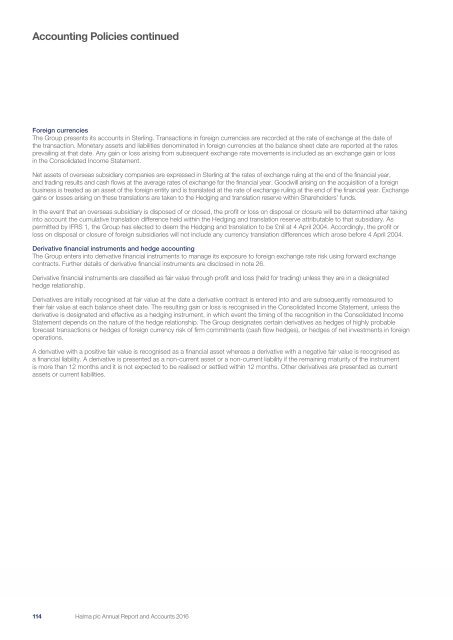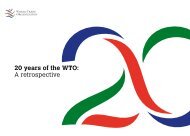Create successful ePaper yourself
Turn your PDF publications into a flip-book with our unique Google optimized e-Paper software.
Accounting Policies continued<br />
Foreign currencies<br />
The Group presents its accounts in Sterling. Transactions in foreign currencies are recorded at the rate of exchange at the date of<br />
the transaction. Monetary assets and liabilities denominated in foreign currencies at the balance sheet date are reported at the rates<br />
prevailing at that date. Any gain or loss arising from subsequent exchange rate movements is included as an exchange gain or loss<br />
in the Consolidated Income Statement.<br />
Net assets of overseas subsidiary companies are expressed in Sterling at the rates of exchange ruling at the end of the financial year,<br />
and trading results and cash flows at the average rates of exchange for the financial year. Goodwill arising on the acquisition of a foreign<br />
business is treated as an asset of the foreign entity and is translated at the rate of exchange ruling at the end of the financial year. Exchange<br />
gains or losses arising on these translations are taken to the Hedging and translation reserve within Shareholders’ funds.<br />
In the event that an overseas subsidiary is disposed of or closed, the profit or loss on disposal or closure will be determined after taking<br />
into account the cumulative translation difference held within the Hedging and translation reserve attributable to that subsidiary. As<br />
permitted by IFRS 1, the Group has elected to deem the Hedging and translation to be £nil at 4 April 2004. Accordingly, the profit or<br />
loss on disposal or closure of foreign subsidiaries will not include any currency translation differences which arose before 4 April 2004.<br />
Derivative financial instruments and hedge accounting<br />
The Group enters into derivative financial instruments to manage its exposure to foreign exchange rate risk using forward exchange<br />
contracts. Further details of derivative financial instruments are disclosed in note 26.<br />
Derivative financial instruments are classified as fair value through profit and loss (held for trading) unless they are in a designated<br />
hedge relationship.<br />
Derivatives are initially recognised at fair value at the date a derivative contract is entered into and are subsequently remeasured to<br />
their fair value at each balance sheet date. The resulting gain or loss is recognised in the Consolidated Income Statement, unless the<br />
derivative is designated and effective as a hedging instrument, in which event the timing of the recognition in the Consolidated Income<br />
Statement depends on the nature of the hedge relationship. The Group designates certain derivatives as hedges of highly probable<br />
forecast transactions or hedges of foreign currency risk of firm commitments (cash flow hedges), or hedges of net investments in foreign<br />
operations.<br />
A derivative with a positive fair value is recognised as a financial asset whereas a derivative with a negative fair value is recognised as<br />
a financial liability. A derivative is presented as a non-current asset or a non-current liability if the remaining maturity of the instrument<br />
is more than 12 months and it is not expected to be realised or settled within 12 months. Other derivatives are presented as current<br />
assets or current liabilities.<br />
114 112<br />
<strong>Halma</strong> plc Annual Report and Accounts <strong>2016</strong>

















